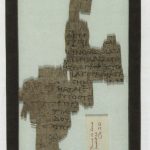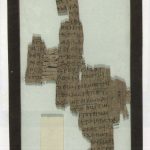| Artefact ID | 241 |
| TM ID | TM 64007 |
| Findspot (DEChriM ID) | 28 (al-Bahnasā) | Class | Textual |
| Material | Papyrus |
| Writing medium | Codex |
| Text content | Literary |
| Language | Greek |
| Description | P.Oxy. II 210 Two fragments containing an unidentified apocryphal gospel. A new reading of the recto (see Landau 2018: 427-480) presents the text as part of an apocalyptic discourse with an angel, though previously read as an infancy narrative; see ed. pr. On the verso, the text mentions the fruit of the good tree (Matt 7:17-19; Luke 6:43-44) and could represent a lost gospel or a sermon; see Blumell / Wayment 2015: 236. No complete lines of writing exist, making it difficult to reconstruct the size of the original codex. Handwriting is a "good-sized, rather irregular uncial" (ed.pr.), "consistent though not elegant" (Blumell/Wayment 2015: 326). Diaeresis, but no punctuation. Large margins give the impression of a well-executed codex. |
| Selection criteria | Literary genre (Non-canonical), Literary genre (Theological), Nomina sacra |
| Date from | 250 |
| Date to | 325 |
| Dating criteria | Palaeography. Dated to the 3rd c. by the ed. pr.; for the most recent date (assessed using a digital microscope), see Landau 2018: 427-480. |
| Absolute/relative date | Relative date |
| Archaeological context | The fragment was found in al-Bahnasā (Oxyrhynchos) during the excavations of Bernard Grenfell and Arthur S. Hunt. |
| Accession number | Cambridge, University Library, Add. Ms. 4048. |
ARTEFACT IDENTIFIERS
Reference edition:
• Landau, Brent C. 2018. "A Re-transcription and Analysis of a Possible Apocryphal Gospel Fragment, Papyrus Oxyrhynchus II 210, Utilizing a Digital Microscope". Ephemerides Theologicae Lovanienses 94 (3). 427-480.
Editio princeps:
• Hunt, Arthur S. and Bernard Grennfell. 1899. The Oxyrhynchus Papyri, part II. Published by the Egypt Exploration Society in Graeco-Roman Memoirs. London. 9-10, no. 210.
Additional bibliography:
• Bernhard, Andrew E. 2006. Other early Christian gospels: a critical edition of the surviving Greek manuscripts. Library of New Testament studies 315. London. 100, 108-113.
• Blumell, Lincoln H. and Thomas Wayment. 2015. Christian Oxyrynchus: Texts, Documents and Sources. Waco, Texas. Papyrus no. 63.
• Ehrman, Bart D. and Zlatko Pleše. 2011. The Apocryphal Gospels: Texts and Translations. New York. 259-265.
• Landau, Brent, Adeline Harrington, and James C. Henriques. 2019. "“What No Eye Has Seen”: Using a Digital Microscope to Edit Papyrus Fragments of Early Christian Apocryphal Writings." Ancient Manuscripts in Digital Culture: Visualisation, Data Mining, Communication. Hamidović, David, Claire Clivaz, and Savant Sarah Bowen, eds. Leiden / Boston. 50-69.
• Porter, Stanley E. 2001. "POxy II 210 as an Apocryphal Gospel and the Development of Egyptian Christianity". Atti del XXII Congresso internazionale di papirologia: Firenze, 23-29 agosto 1998, Andorlini, Isabella et al., eds. Florence. 1095-1108.
• Porter, Stanley E. 2006. "Textual criticism in the light of diverse textual evidence for the Greek New Testament: An expanded proposal". New Testament manuscripts: Their Texts and Their World. Kraus, Thomas J. and Tobias Nicklas, eds. Leiden. 325-330.
• Roberts, Colin H. 1987. “An Early Christian Papyrus”. Miscellània papirològica Ramon Roca-Puig. Janeras, Sebastià, ed. Barcelona. 293-296.
• Tzerpos, Vasilios D. 2014. "Ὁ πάπυρος τῆς Ὀξυρύγχου 210 (P. Oxy. 210) καὶ ἡ σχέση του μὲ τὰ βιβλία τοῦ Κανόνος τῆς Κ.Δ.". Θεολογία 85 (4). 31-44.
• van Haelst, Joseph. 1976. Catalogue des papyrus littéraires juifs et chrétiens. Paris. Description no. 1151.
• Wayment, Thomas A. 2013. The text of the New Testament apocrypha (100-400 CE). London. 187-189.


 Json data
Json data





